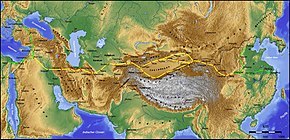The History of Spices
 Spices provide insight into the relationships between cultures and the expansion of human knowledge across the globe.
Spices provide insight into the relationships between cultures and the expansion of human knowledge across the globe.The history of spices often examines the manner spices from the ancient world were gathered, grown, processed, and transported. For instance, spices like nutmeg, cinnamon, and cloves, which are most often associated with the early world were actually more common among the ancient civilizations because these particular spices did not need to be ground into a powder to transport or consume. In the modern world spices ground into a powder have actually added to their cost.
Earliest Recipes

The history of spices wouldn’t be complete without examining some of the world’s oldest spice recipes. In ancient China, a spice blend was developed to represent Wu Yi (the five tastes). This spice blend encompasses all five tastes—sweet, sour, bitter, salty, and umami—and uses five different spices to symbolize each of the five tastes. This Chinese 5 spice is a mixture of star anise, cloves, cinnamon, Sichuan (Szechuan) peppercorns, and fennel seeds. In ancient Egypt, a similar blend was developed based on the colors of the desert and featured black pepper. The Romans used black pepper studded with red peppers. The Greeks developed their own special blend of spices, which included red pepper, juniper berries, and cinnamon, while the Persians used nutmeg, cardamom, anise, and turmeric.
Food PreservationSpices also played an important role in the preservation of food in the ancient world. Both Egyptians and Romans used Coriander seed oil to preserve foods needing to be kept cold. These spices also helped promote the consumption of fruits, nuts, seeds, and legumes throughout the ancient world. Salt has also been used as a preservative for ages and works to preserve food by drawing water out of food and dehydrating it. All living things require water and cannot grow in the absence of it, including the bacteria which can cause food poisoning.
Salt also kills microbes. High salt is toxic to most (not all) microbes because of the effect of osmolarity, or water pressure. Water diffuses between cells in the environment so that the concentration of solutes (such as salt) is the same on both sides of the cell. In very high salt solutions, many microbes will rupture due to the difference in pressure between the outside and inside of the organism. High salt can also be toxic to the internal processes of microbes, affecting DNA and enzymes.

Spices, and the routes they traveled, most notably the silk road, helped launch a world economy. The Silk Road was and is a network of trade routes connecting the East and West, and was central to the economic, cultural, political, and religious interactions between these regions from the 2nd century BCE to the 18th century.
The Silk Road derives its name from the lucrative trade in silk carried along its length, beginning in the Han dynasty in China (207 BCE–220 CE). The Han dynasty expanded the Central Asian section of the trade routes around 114 BCE through the missions and explorations of the Chinese imperial envoy Zhang Qian, as well as several military conquests. The Chinese took great interest in the security of their trade products, including rare spices, and extended the Great Wall of China to ensure the protection of the trade route.
The Silk Road trade played a significant role in the development of the civilizations of China, Korea, Japan, the Indian subcontinent, Iran, Europe, the Horn of Africa and Arabia, opening long-distance political and economic relations between the civilizations. Though silk was the major trade item exported from China, many other goods and ideas were exchanged, including religions (especially Buddhism), syncretic philosophies, sciences, technologies like paper and gunpowder, and of course spices. So in addition to economic trade, the Silk Road was a route for cultural trade among the civilizations along its network.
The post The History of Spices appeared first on Trina Spillman Author.



